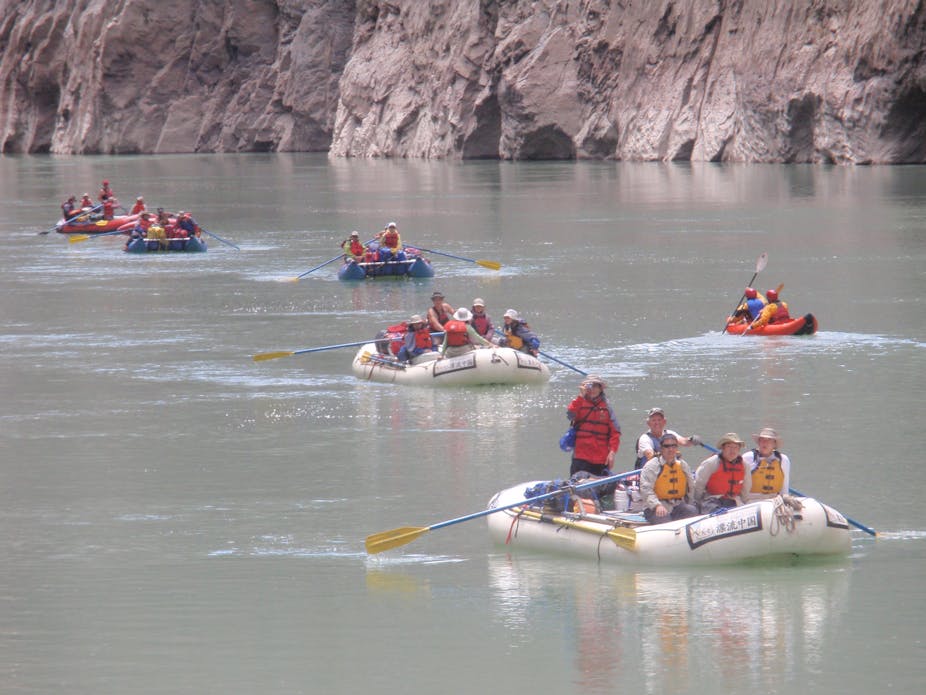For countries that promote themselves as tourist destinations, China has - for some years - been the new Japan. Two decades ago, tourist towns such as Australia’s Gold Coast put up bilingual signs and the travel industry paid 20% loadings to locals who could speak Japanese.
For the past decade, the Australian tourism industry has braced itself for a corresponding influx of package tourists from China. In practice, this has happened much more slowly than projected.
Individual wealth in China has increased enormously, but government controls on overseas travel have relaxed much more slowly. In some ways this was lucky, because we really weren’t ready. Fortunately, the focus to date has been on very tightly guided city shopping tours. Our state and federal governments, however, would prefer inbound Chinese tourists to provide new economic opportunities in regional electorates.
There are some practical difficulties. Australian rural destinations are not at all equipped to handle high volumes of tourists who speak only Chinese, expect to eat Chinese food and are unfamiliar with Australian cultural behaviour. We will have to adapt, as we did for the Japanese.
One of the critical questions, if Chinese tourists begin to visit Australian country areas, is what they will do. What activities will they want, and can we provide them?
Whitewater lessons
For regional destinations, the attractions are outdoor activities based on scenery, nature and adventure. We recently studied the Chinese whitewater rafting industry, known as piaoliu, with unexpected results.
Many of Asia’s rivers have been dammed for hydroelectric power, with large-scale environmental consequences. Many more dams are under construction, especially on the great rivers of western China: the Salween, the Mekong and the Yangtze.
To show Chinese politicians and business people just what is being lost by flooding these giant canyons, a small Chinese company called Last Descents has run a series of river trips through otherwise inaccessible areas. The company uses rafts imported from the USA, with guides trained on the Colorado Grand Canyon.
It’s possible to estimate the likely future economic scale of river tourism in China and compare it with the economic value of electricity produced by the dams, assuming that the rafting on each of the three great rivers of western China could grow to the scale of the Colorado Grand Canyon, at similar prices. That is a very reasonable assumption, and shows the value of the rivers for recreation. But the question is, how long would it take for the industry to grow?
Different strokes
We knew that there was already some domestic commercial rafting in China, but we had no idea of its economic scale. With the help of a Chinese‑speaking colleague from the USA and three colleagues from within China, we set out specifically to study the Chinese domestic rafting sector.
Surprisingly, we found the domestic industry far outstripped the international inbound operations, but using a completely different model.
In the Western model of whitewater rafting, which is standard in most of the world, each raft is self‑contained. It is steered and propelled either with oars or with paddles, with a guide who coordinates the paddle strokes and picks a path down the river. The rafts manoeuvre actively to take a safe route through each rapid. If anyone falls out or the raft flips, they have to swim back to the raft and haul themselves in with help from the other rafters, and sometimes a safety kayaker.

The Chinese system is completely different. The operators are private corporations or public‑private partnerships. They are granted exclusive long‑term leases over short sections of small rivers, which they modify heavily through engineering works.
The clients, up to 10,000 per day at the most popular sites, sit in small oval rafts and are flushed down the watercourse with no paddles and no control. If they fall out they are rescued by lifeguards stationed along the banks. In many ways, the activity is less like an active adventure sport and more like a fairground ride.
Perhaps the most surprising outcome was not that the piaoliu model is so different from Western rafting, but that the scale of the piaoliu sector is already so large. The best estimate is that around 80 million young Chinese have already experienced piaoliu. Most of the companies operate near very large population centres, and piaoliu is sold along with other activities as part of one‑day package bus tours.
There are two implications for countries such as Australia that are keen to offer outdoor activities to Chinese tourists. The first is that there is a giant pool of potential clients for Australian adventure tours. City shopping is certainly not their only interest.
The other side of the coin, however, is that what these Chinese tourists expect is very different from what we currently offer. The English word rafting is translated as piaoliu, so if Chinese tourists buy a rafting tour in Australia, piaoliu is what they will expect.
What they will get, however, are larger rivers, more powerful rapids, much more active involvement and much greater responsibility for their own personal safety. Unless Australian raft tour operators appreciate this, and adjust their trip briefings and safety procedures accordingly, there will be a much greater risk of accidents for urban Chinese outbound tourists than for Australians who have grown up around the ocean.
More generally, international tourism marketing agencies need to learn more about the domestic activities of their inbound markets, since that influences the expectations of individual tourists.

